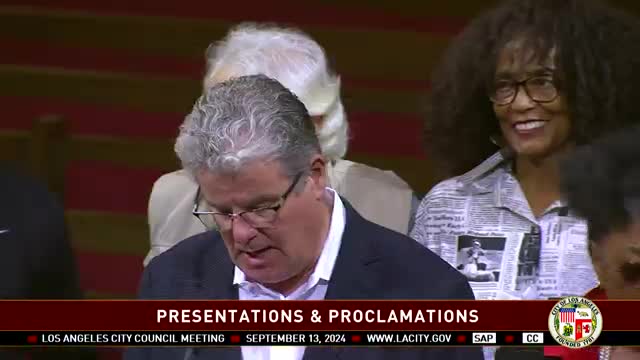Watts Towers Arts Center celebrates 103 years with Day of the Drum and Jazz Festivals
September 13, 2024 | City Council, Los Angeles City, Los Angeles County, California
This article was created by AI summarizing key points discussed. AI makes mistakes, so for full details and context, please refer to the video of the full meeting. Please report any errors so we can fix them. Report an error »

The Los Angeles City Council meeting on September 13, 2024, celebrated the upcoming 42nd annual Watts Towers Day of the Drum Festival and the 47th annual Simon Rodia Watts Towers Jazz Festival. The event marks a significant milestone, as it coincides with the 103rd anniversary of the iconic Watts Towers, a collection of 17 interconnected structures created by Italian immigrant Simon Rodia between 1921 and 1954.
Councilmember McOsker opened the meeting by highlighting the cultural importance of the Watts Towers, which serve as a symbol of creativity and resilience for the local Black and Latino communities. He emphasized the towers' role in promoting social and economic justice since gaining international attention in 1959. The towers are recognized as a national historic landmark and are listed on the National Register of Historic Places.
Daniel Turica, General Manager of the Department of Cultural Affairs, spoke about the ongoing efforts to keep the spirit of the Watts Towers alive through arts education and community engagement. He acknowledged the contributions of the Watts Towers Arts Center, which has been a vital resource for local artists and students since 1961.
Rosie Lee Hooks, Director of the Watts Towers Arts Center, expressed gratitude for the recognition from the City Council and emphasized the center's commitment to providing a nurturing environment for young people through various art disciplines. She invited council members to visit the center and experience its offerings firsthand.
Council members praised the Watts Towers as a cultural treasure and acknowledged the importance of arts programming in the community. They highlighted the need for continued support for cultural activities, which often face financial challenges.
The meeting concluded with a reminder of the upcoming festivals on September 28 and 29, inviting the public to participate in the celebrations that showcase the rich artistic heritage of the Watts community. The council's recognition of the Watts Towers and its associated events underscores the significance of cultural landmarks in fostering community identity and pride in Los Angeles.
Councilmember McOsker opened the meeting by highlighting the cultural importance of the Watts Towers, which serve as a symbol of creativity and resilience for the local Black and Latino communities. He emphasized the towers' role in promoting social and economic justice since gaining international attention in 1959. The towers are recognized as a national historic landmark and are listed on the National Register of Historic Places.
Daniel Turica, General Manager of the Department of Cultural Affairs, spoke about the ongoing efforts to keep the spirit of the Watts Towers alive through arts education and community engagement. He acknowledged the contributions of the Watts Towers Arts Center, which has been a vital resource for local artists and students since 1961.
Rosie Lee Hooks, Director of the Watts Towers Arts Center, expressed gratitude for the recognition from the City Council and emphasized the center's commitment to providing a nurturing environment for young people through various art disciplines. She invited council members to visit the center and experience its offerings firsthand.
Council members praised the Watts Towers as a cultural treasure and acknowledged the importance of arts programming in the community. They highlighted the need for continued support for cultural activities, which often face financial challenges.
The meeting concluded with a reminder of the upcoming festivals on September 28 and 29, inviting the public to participate in the celebrations that showcase the rich artistic heritage of the Watts community. The council's recognition of the Watts Towers and its associated events underscores the significance of cultural landmarks in fostering community identity and pride in Los Angeles.
View full meeting
This article is based on a recent meeting—watch the full video and explore the complete transcript for deeper insights into the discussion.
View full meeting
